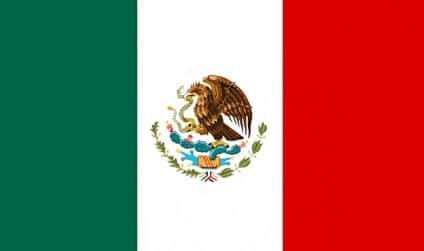February 24th of the Flag of Mexico.
One of the Mexican patriotic symbols is the flag that is considered as one of the most beautiful in the world. It
is also a symbol that represents independence, justice and freedom, its
origins go back to 1821, but it is since 1940 that it is given official
honor as an intangible part of Mexican identity.
The day of the
Flag of Mexico is celebrated the 24 of February, and this is in memory
of the proclamation of the Plan of Iguala by Augustine de Iturbide the
same day of February of 1821.
Throughout
Mexican history the flags were changed, but the current flag was adopted
by decree on September 16, 1968, and confirmed by law on February 24,
1984. It is believed that one of the motives for the final
redesign of the flag was the role of Mexico as host of the XIX Olympic
Games to be held in the country, in addition to its similarity with the
Italian flag to use the same triad of colors.
Structure of the flag.
Physically, the flag is a rectangle divided into three vertical stripes of equal proportion, whose colors are - from left to right - green, white and red.
To the center of the Mexican flag, on the white color, is the National Coat of Arms, a real eagle, seen laterally, perched on a nopal and devouring a snake.
Physically, the flag is a rectangle divided into three vertical stripes of equal proportion, whose colors are - from left to right - green, white and red.
To the center of the Mexican flag, on the white color, is the National Coat of Arms, a real eagle, seen laterally, perched on a nopal and devouring a snake.
The Shield refers to Lake
Texcoco and is based on the legend of how the Aztec people wandered for
hundreds of years to found their city. The gods
told them to settle down wherever they saw an eagle perched on the
cactus devouring the snake and that's how the city of Tenochtitlán was
born, which became Mexico City.
Meaning of colors.
The colors of the flag originated from the flag of the Army of the Three Guarantees or Army Trigarante, in 1821.
Originally the meaning of the colors was:
Originally the meaning of the colors was:
- White: religion (faith in the Catholic Church, politically dominant at the time)
- Red: union (between Europeans and Americans as a new autonomous and unified population)
- Green: freedom (Independence obtained by the rising Mexican people)
Later, it changed by the economic and political separation of the Church and the State, by the then president Benito Juárez. The colors of the Patriotic Labrador symbolize the following:
- Green: hope
- White: unit
- Red: the blood of the national heroes
For
all Mexicans to see the flag of Mexico is a great pride, the skin is
erect from just watching it wave and listen to the Mexican national
anthem.



Comentarios
Publicar un comentario